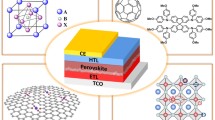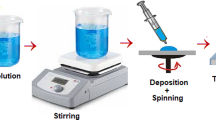Abstract
The analytical treatment of a model considering the electrooxidation of p-porous silicon layers under galvanostatic conditions is able to give account of experimental facts such as the shape and location of the electroluminescence peak as well as of the spectral shift of the electroluminescence peak produced by oxidation. The proposed model considers electroluminescence to be the result of electron injection into the conduction band by an adsorbed intermediate produced by electrooxidation of the surface coverage with hydrogen or siloxene of the silicon nanocrystallites. The access of holes to the surface is made possible by low accumulation layer conditions and is the rate determining step in the electroluminescence mechanism. In this way it is possible to give a satisfactory explanation to the shift towards the blue experimented by the electroluminiscence emission maximum as a consequence of electrooxidation.
Similar content being viewed by others
References
L.T. Canham: “Silicon Quantum Wire Array Fabrication by Electrochemical and Chemical Dissolution of Wafers”, Appl. Phys. Lett., Vol. 57(10), (1990), pp. 1046–1048.
N. Koshida and H. Koyama: “Visible Electroluminescence from Porous Silicon”, Appl. Phys. Lett., Vol. 60(3), (1992), pp. 347–349.
V. Lehmann and U. Gösele: “Porous Silicon Formation. A Quantum Wire Effect”, Appl. Phys. Lett., Vol. 58(8), (1991), pp. 856–858.
A.G. Cullis and L.T. Canham: “Visible Light Emission due to Quantum Size Effects in Highly Porous Crystalline Silicon”, Nature, Vol. 353, (1991), pp. 335–338.
S. Gardelis, J.S. Rimmer, P. Dawson, B. Hamilton, R.A. Kubiak, T.E. Whall and E.H.C. Parker: “Evidence for Quantum Confinement in the Photoluminescence of Porous Si and SiGe”, Appl. Phys. Lett., Vol. 59(17), (1991), pp. 2118–2120.
M.S. Brandt, H.D. Fuchs, M. Stutzmann, J. Weber and M. Cardona: “The Origin of Visible Luminescence from Porous Silicon. A New Interpretation”, Solid State Commun., Vol. 81(4), (1992), pp. 307–312.
L.M. Peter, A.M. Borazio, H.J. Lewerenz and J. Stumper: “Photocurrent Multiplication During Photodissolution of Normal Si in NH4F. Deconvolution of Electron Injection Steps by Intensity Modulated Photocurrent Spectroscopy”, J. Electroanal. Chem., Vol. 290(1–2), (1990), pp. 229–248.
R. Herino: “Luminescence of Porous Silicon after Electrochemical Oxidation”, In: J.C. Vial and J. Derrien (Eds.): Porous Silicon Science and Technology, Springe Verlag, 1995, Chapter IV, pp. 53–66.
J. González Velasco: “A Kinetic Study of the Origin of Electroluminescence in Porous Silicon Layers”, Electrochimica Acta, Vol. 46(19), (2001), pp. 2991–3000.
Y.V. Pleskov and Yu.Ya. Gurevich: Semiconductor Photoelectrochemistry, Consultants Bureau, New York, 1986.
R.L. Schmith and S.D. Collins: “Porous Silicon Formation Mechanism”, J. Appl. Phys., Vol. 71(8), (1992), pp. R1-R22.
Author information
Authors and Affiliations
About this article
Cite this article
Velasco, J.G. On the mechanism of electroluminescence emission by porous silicon layers. cent.eur.j.chem. 3, 470–481 (2005). https://doi.org/10.2478/BF02479276
Received:
Accepted:
Issue Date:
DOI: https://doi.org/10.2478/BF02479276




